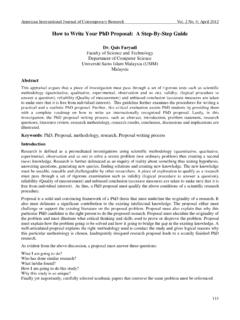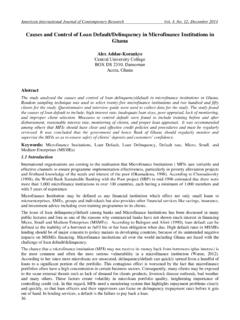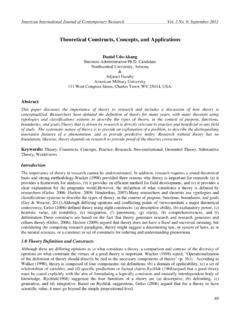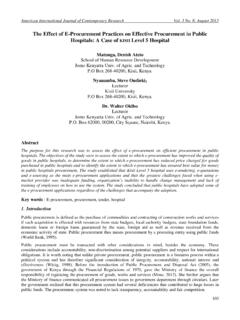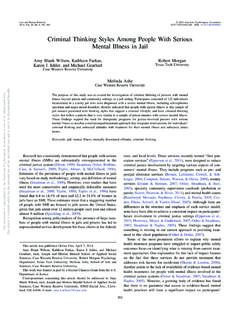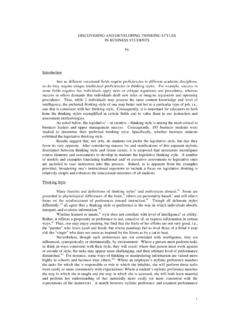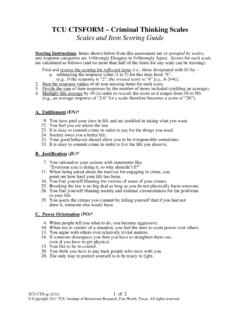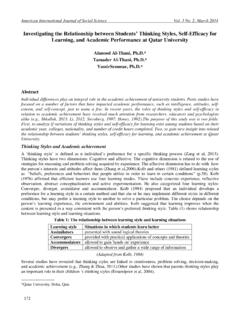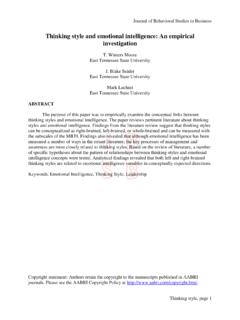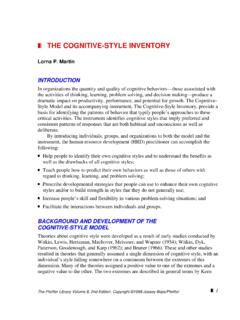Transcription of Thinking Styles In Light of Sternberg's Theory Prevailing ...
1 American International Journal of Contemporary Research Vol. 2 No. 3; March 2012 140 Thinking Styles "In Light of Sternberg's Theory " Prevailing Among the Students of Tafila Technical University and Its Relationship with Some Variables Dr. Jihad Turki Tafilah Technical University Faculty of Educational Sciences Educational Psychology Section Jordan Abstract The study aimed to recognize The Thinking Styles "in Light of Sternberg's Theory " Prevailing among the students of Tafila Technical University and its relationship with some Variables. The sample consisted of (800) students (male and female) chosen in stratified, clustered and random method. The researcher used a list of methods for Sternberg and Wagner (1991) for the instrument of the study. The results indicated that the common Thinking Styles came mid in general , it also indicated that there are no statistically differences on level of ( = ) attributed to the variable of gender in all the Styles except the legislative and judicial style, the differences came to the favor of males.
2 The differences of the executive style came to the favor of females. Key Words: Thinking , Sternberg and Wagner, Styles Theoretical framework Thinking is considered the mental process in which the learner develops through mental interaction processes between the individual and the experiences that he acquires to develop structures of knowledge and access to new assumptions and expectations (Qatami, 2001). Thinking includes making many mental and knowledge processes, such as attention, cognition, memory, classification, reasoning, analysis, comparing and generalizing, and synthesis, (Abou El-Maati, 2005). Sternberg defines the Thinking Styles way of Thinking as the individual's preferred Thinking style when doing business, and describes how the individual uses or exploits the capacities that he owns (such as knowledge )which is not an ability but it is located between the character and capacities (character - ways of Thinking - capacity) (Sternberg.)
3 2002). Sternberg (1988, 1993, 1997) classified individuals according to their ways of Thinking into thirteen way of Thinking , and distributed it into five main categories each of which comprises a variety of methods, namely: First: the ways of Thinking in terms of the form: 1. Monarchic style, individuals are characterized by going towards a single goal all the time, they are flexible, and able to analyze and think logically is low. They prefer works that highlight their individuality. (Sternberg, 1994). 2. Hierarchic style: the owners of this method tend to do many things at one time. They put their goals in the form of hierarchy depending on their importance and priority. They are realistic, logical and organized in solving problems and decision-making. (Sternberg & Wagner, 1991).
4 3. Anarchic method: they tend to adopt a method of random and non-compliant in a particular order to solve the problems, their performance is better when the tasks and positions that are assigned to them are disorganized, and they are confused (Sternberg & Wagner, 1991, 2006, Tayeb, 2006). 4. Oligarchic style: these individuals are characterized by being nervous, confused and they have many conflicting goals, all of these goals are equally important for them. (Sternberg 2006 , Grigorenko & Sternberg, 1995). Second: The ways of Thinking in terms of function: 1. Legislative style: they prefer the problems which require them to devise new strategies and to create their own laws and they enjoy giving commands (Abu Gado and Nofal, 2007; Monthly, 2006, Zhang, 2004). Centre for Promoting Ideas, USA 141 2.
5 Executive style: The advocators of this method prefer to use the ways that already exists to solve problems, and the application and implementation of laws. They do not start work until they know when? Why, and Where? And Who? .. If he gets these answers, he will be able to start work. (Obeidat and Abu Assameed, 2007) (Grigorenko & Sternberg, 1995). 3. Judicial style: The advocators of this method care about the assessment of the stages of the work and the results. They often ask questions such as: Why? What is the reason? What is assumed, (Bernardo et al., 2002).They analyze the main idea in the scientific stance and hate experimentation, evaluate the work of others, and hate to be evaluated by others. They prefer problems that allow them to analyze and evaluate the existing objects and ideas (monthly, 2006; Obeidat and Abu Assameed, 2007).
6 Third: Methods of Thinking In Terms Of Level: 1. Global style: They prefer to deal with broad , abstract and relatively large and. high-level concepts. They prefer change and innovation, and vague positions. They often ignore the details. 2. Local style: The advocators of this method characterized by being attracted by the practical situations. And described by Sternberg (Sternberg) as subjective because they are putting an account of everything and they do not leave anything to chance or luck. (Sternberg & Wagner, 1991, Sternberg, 2002). Fourth: The ways of Thinking in terms of the trend: 1. Liberal style: The followers of this method tend to go beyond the laws and measures, and the tendency to be ambiguous and unfamiliar positions. They are seeking through the tasks undertaken by them to bypass laws that imposed upon them, whether at work or in school in order to bring the biggest possible change (Sternberg2006, Bernardo et al, 2002).
7 2. Conservative style: they prefer situations that are familiar in life, and they are characterized by diligence and order, they follow the rules and procedures that exist, and they refuse change and would prefer the least possible change. (Abu Hashim, 2007). Fifth: The Ways of Thinking In Terms Of Scope: 1. External style: followers of this method tend to work, interact and collaborate with others within the team, and they have a sense of social contact with others comfortably and easily. (Sternberg & Wagner, 1991, Zhang & Sternberg, 2002). 2. Internal Style: The followers of this style prefer to work individually; they are introvert and tend to be lonely. They are directed toward work or task, and they are characterized by internal focus, and they prefer the analytical and creative problems.
8 (Zhang, 1999). By reviewing the literature in the area of the ways of Thinking , we find a diversity of research and studies. Some of them studied the impact of academic specialization of educational achievement and years of study on the type of the preferred Thinking style in the Light of the Theory of Sternberg. Where the study of Grigorrenko & Sternberg (1997) showed a negative significant correlation between the executive style of Thinking and academic achievement. Also the study of Zhang & Sternberg, 1998) showed the presence of a positive significant correlation between Styles of Thinking (the conservative, hierarchical and internal) and academic achievement. While it found a negative correlation between Thinking Styles (legislative, liberal and external) and academic achievement.
9 And the results of (Ajwa, 1998) showed that there was no statically significant correlation between Styles of Thinking and academic achievement with the exception of the hierarchical style of Thinking , which positively and statistically significantly correlated with academic achievement, and the absence of statistically significant differences between the students of scientific and literary disciplines in their Styles of Thinking , with the exception of the Judicial and monarchic Styles where the differences were statistically significant for students of literary disciplines. The results of the study of (Bernardo & et al 2002) indicated the presence of a high positive correlation between the executive style and academic achievement, while there is no significant correlation between the legislative style and the academic achievement.
10 The study of (Sahloul and mohammed, 2009) distinguished students with high performance goals trends in the following Styles of Thinking (global, internal, Anarchic, Oligarchic, conservative, liberal), while students with low orientation performance objectives with are distinguished by the monarchy style. A study (Zhang, 2002) indicated that there are differences between the sexes in the legislative and liberal Styles of Thinking in favor of males, while there are no differences between the sexes in the rest of the Styles of Thinking . American International Journal of Contemporary Research Vol. 2 No. 3; March 2012 142 The problem of the study and its importance: The basic principle in the ways of Thinking is to help students make the fullest possible use of the methods of teaching and learning, and to realize the best way to invest their true potentials, and its psychological case of the student.

